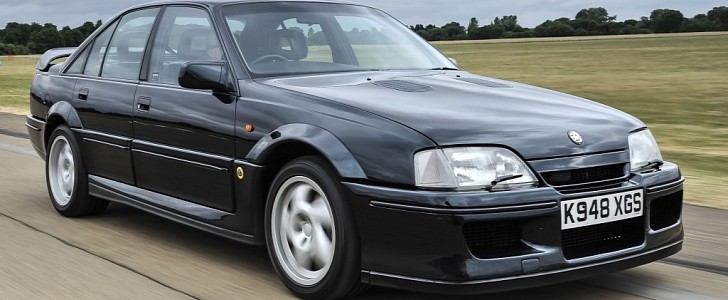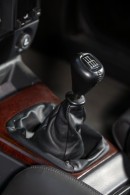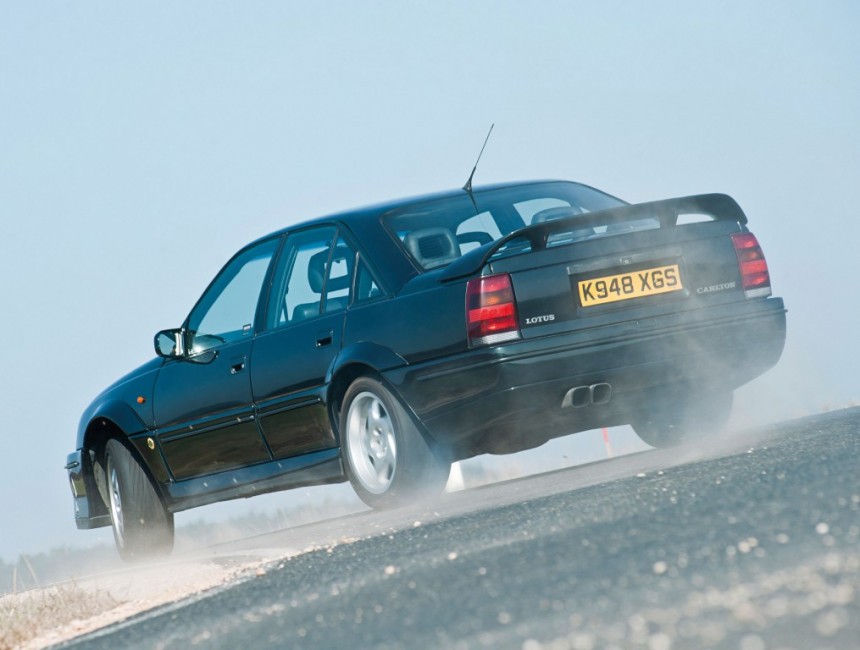Following the death of Colin Chapman, the peeps at General Motors bought Lotus. It’s during this era the Carlton was born, a four-door performance sedan that was offered exclusively in dark green.
Envisioned in the late ‘80s, the Carlton takes its name from the Vauxhall Carlton. Known as the Opel Omega in other European markets, the E-segment family car could be had with four- and six-cylinder powerplants.
Internally known as Type 104, the go-faster variant had to be a little more spirited to be worthy of the Lotus insignia. Although every car started out in the guise of an Omega 3000 GSi in Russelsheim, the British automaker extensively modified these cars in Hethel to create the Carlton.
In the first instance, Lotus had to strip out pretty much everything in order to affix the no-nonsense body kit. As far as the straight-six engine is concerned, modifications over the bone-stock mill include the strengthened block, forged steel crankshaft, Mahle pistons, beefier connecting rods, a milled cylinder head for slightly reduced compression, an extended stroke that brought up the displacement by 646 cc, and two humongous turbochargers.
Set at 10 psi of boost pressure, the Garrett T25 twins are the secret to the supercar-shaming performance of the Carlton. Rated at 377 hp and 419 pound-feet (568 Nm) at 4,200 revolutions per minute, this engine also boasts an upgraded ignition system, a Delco control unit, twin oil coolers, a custom exhaust with three-way cats, and a Behr water-to-air intercooler.
The 3.6-liter engine is connected to a six-speed manual transmission, namely the ZF S6-40 that replaced the Doug Nash 4+3 stick shift in the fourth-generation Chevrolet Corvette. Fitted with a hydraulic single-plate clutch, the manual tranny is connected to a limited-slip rear differential.
Tipping the scales at nearly 3,650 pounds (1,655 kilograms), the Carlton is a very different animal from the Omega 3000 GSi on which it’s based. Despite a very long first gear, the Lotus-branded sleeper can reach 100 kilometers per hour (62 miles per hour) in 5.4 seconds. The V8-powered and mid-engined Ferrari 348 TB, by comparison, needs precisely 5.6 seconds.
In terms of top speed, the Carlton is officially rated at 176 miles per hour (283 kilometers per hour). That made it faster than the Porsche 911 Turbo, which is a testament to the British automaker’s engineering excellence.
Crowned the fastest four-door production car in 1990, the Carlton was originally priced at 48,000 pounds sterling. That’s £116,500 adjusted for inflation, a figure which converts to $157,305 at current exchange rates.
To enhance the Omega’s rather boring exterior, Lotus equipped the Carlton with fiberglass bumpers, a quirky spoiler out back, side skirts, body-colored moldings, flared wheel arches, and hood louvers. Lotus badges on the front fenders and tailgate also need to be mentioned, along with single-piece Ronal forged alloys that measure 17” by 8.5” up front and 9.5” out back.
Longer, wider, and lower than the donor vehicle, the Carlton is upholstered in Connolly leather and suede. Walnut inserts, a non-airbag steering wheel, branded instrumentation, and manually-adjustable seats are featured on the inside, where you can also find an electric sunroof and air conditioning.
There were no extras to speak of through 1992 when production ended. The only alteration brought to the Carlton during its very short life concerns the audio system, which was upgraded from the 800th unit onward. GM intended to sell 1,100 cars, but as fate would have it, only 950 left the plant.
630 units were badged as the Lotus Omega for non-UK markets, while the remainder were delivered in the United Kingdom as the Lotus Carlton. Criticized for its vague steering and heavy clutch, the most exciting sedan of the early 1990s ultimately tanked because of the prohibitive sticker price and the short recession that gripped all corners of the Western world.
From the standpoint of common issues, would-be owners should be aware that even well-maintained vehicles can snap timing chains, leading to catastrophic internal damage. The viscous fans are known for causing head gasket failures, and the clutch is prone to fail as well. Similar to the Vauxhall Carlton, rust is a critical concern. As such, make sure to double-check the door bottoms and around the sunroof for any sign of corrosion.
Somewhat curious for a rarefied classic, the Lotus Carlton/Omega doesn’t cost an arm and a leg on the second-hand market. Good examples usually sell for hammer prices of more than £50,000, while the very best of the very best often go for more than £70,000 ($94,720) sans the buyer’s premium.
Internally known as Type 104, the go-faster variant had to be a little more spirited to be worthy of the Lotus insignia. Although every car started out in the guise of an Omega 3000 GSi in Russelsheim, the British automaker extensively modified these cars in Hethel to create the Carlton.
In the first instance, Lotus had to strip out pretty much everything in order to affix the no-nonsense body kit. As far as the straight-six engine is concerned, modifications over the bone-stock mill include the strengthened block, forged steel crankshaft, Mahle pistons, beefier connecting rods, a milled cylinder head for slightly reduced compression, an extended stroke that brought up the displacement by 646 cc, and two humongous turbochargers.
Set at 10 psi of boost pressure, the Garrett T25 twins are the secret to the supercar-shaming performance of the Carlton. Rated at 377 hp and 419 pound-feet (568 Nm) at 4,200 revolutions per minute, this engine also boasts an upgraded ignition system, a Delco control unit, twin oil coolers, a custom exhaust with three-way cats, and a Behr water-to-air intercooler.
The 3.6-liter engine is connected to a six-speed manual transmission, namely the ZF S6-40 that replaced the Doug Nash 4+3 stick shift in the fourth-generation Chevrolet Corvette. Fitted with a hydraulic single-plate clutch, the manual tranny is connected to a limited-slip rear differential.
Tipping the scales at nearly 3,650 pounds (1,655 kilograms), the Carlton is a very different animal from the Omega 3000 GSi on which it’s based. Despite a very long first gear, the Lotus-branded sleeper can reach 100 kilometers per hour (62 miles per hour) in 5.4 seconds. The V8-powered and mid-engined Ferrari 348 TB, by comparison, needs precisely 5.6 seconds.
In terms of top speed, the Carlton is officially rated at 176 miles per hour (283 kilometers per hour). That made it faster than the Porsche 911 Turbo, which is a testament to the British automaker’s engineering excellence.
To enhance the Omega’s rather boring exterior, Lotus equipped the Carlton with fiberglass bumpers, a quirky spoiler out back, side skirts, body-colored moldings, flared wheel arches, and hood louvers. Lotus badges on the front fenders and tailgate also need to be mentioned, along with single-piece Ronal forged alloys that measure 17” by 8.5” up front and 9.5” out back.
Longer, wider, and lower than the donor vehicle, the Carlton is upholstered in Connolly leather and suede. Walnut inserts, a non-airbag steering wheel, branded instrumentation, and manually-adjustable seats are featured on the inside, where you can also find an electric sunroof and air conditioning.
There were no extras to speak of through 1992 when production ended. The only alteration brought to the Carlton during its very short life concerns the audio system, which was upgraded from the 800th unit onward. GM intended to sell 1,100 cars, but as fate would have it, only 950 left the plant.
630 units were badged as the Lotus Omega for non-UK markets, while the remainder were delivered in the United Kingdom as the Lotus Carlton. Criticized for its vague steering and heavy clutch, the most exciting sedan of the early 1990s ultimately tanked because of the prohibitive sticker price and the short recession that gripped all corners of the Western world.
From the standpoint of common issues, would-be owners should be aware that even well-maintained vehicles can snap timing chains, leading to catastrophic internal damage. The viscous fans are known for causing head gasket failures, and the clutch is prone to fail as well. Similar to the Vauxhall Carlton, rust is a critical concern. As such, make sure to double-check the door bottoms and around the sunroof for any sign of corrosion.
Somewhat curious for a rarefied classic, the Lotus Carlton/Omega doesn’t cost an arm and a leg on the second-hand market. Good examples usually sell for hammer prices of more than £50,000, while the very best of the very best often go for more than £70,000 ($94,720) sans the buyer’s premium.














